by Nina
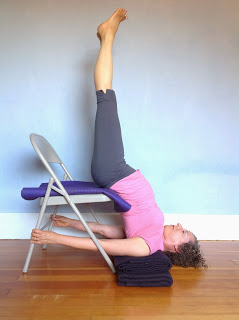 |
| Full Chair Shoulderstand (My Happy Place |
In her interview with us (see Judith Lasater on Yoga and Aging), Judith Lasater mentioned the poses that she currently practices, citing “especially Viparita Karanai (Legs Up the Wall pose), Supported Sarvangasana (Shoulderstand) on the chair and Supported Halasana (Plow pose) on the Halasana bench.” In my post Judith Lasater’s Favorite Poses, I talked about these poses and why, even though they may be a little tricky to learn, they’re so worth the effort. On Monday, I described Supported Halasana in detail. Today, at last, I’m going to tackle Chair Shoulderstand! To be honest, when you first learn how to do this pose, it is one of the most challenging to get in and out of. So I normally teach people how to do Chair Shoulderstand in person. But I think it’s worth having the instructions and photographs showing the process for those of you who may have seen a demonstration once and forgotten the steps, as well as for any brave souls who are willing just to give it a try.
I certainly encourage you to try Chair Shoulderstand and, if you like it, to add it to your home practice because this variation of Shoulderstand will allow you experience the legendary “soothing” quality of Shoulderstand. Because you are completely inverted in this pose, the relaxation response will take effect quite quickly (see Why You Should Love Your Baroreceptors). Your neck is also flexed in the pose, which enhance the relaxation (see More Love for Baroreceptors). And you can use the supported version of Shoulderstand in place of full Shoulderstand in any sequence (or class) that includes full Shoulderstand.
Instructions: To do this pose, you just need a sturdy chair with four legs. It’s okay if the chair has a bar between the front legs or a back panel.
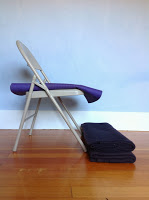
1. Start by placing a folded yoga mat on the chair seat, letting part of the mat extend over the front edge of the chair. (If you’re tall, you may need to place a folded blanket or two on the chair seat to support your pelvis.) Then place two yoga blankets, folded lengthwise into long rectangles, in front of the chair legs with the folded edges away from the chair. All the props should be on the floor, not on a yoga mat because when you come out of the pose, you’ll need to slide the props. If you’re nervous about doing the pose on your own, you could have a friend hold the chair steady for you just for psychological reassurance.
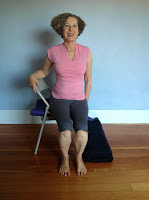 2. Next, sit sideways on the chair seat.
2. Next, sit sideways on the chair seat.
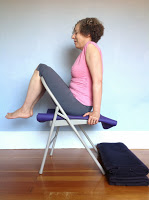
3. Steadying yourself with your hands, swing your legs over the chair back, keeping your knees bent.
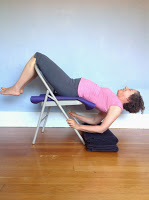
4. Now comes the tricky part. Leaving your legs bent over the chair back (that part is really important as it prevents you from pulling the chair over), place your hands on the chair legs as you scoot your head and shoulders down toward the blanket. Keeping your legs over the chair back, allow your shoulders to come to rest on the edge of the folded blanket (they must actually touch the blanket, not hang in the air above it, so no cheating!) while the back of your head comes to rest on the floor (your neck should be free).
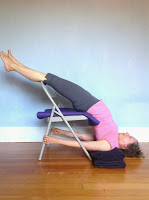
5. Once you shoulders are resting fully on the blanket stack, one at a time thread your arms underneath the chair seat and grab onto the back legs of the chair (while still keeping your legs on the chair back!). If you can’t do this because your shoulders are tight or if you have broad shoulders, take your arms outside the chair legs and grab onto back legs of the chair from the outside.
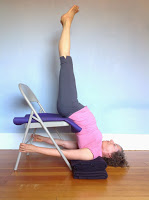
6. Once you are holding onto the back chair legs with your hands—and only then!—you can bring one leg at a time off the chair seat into a vertical position.
Congratulations you’ve made it into a Chair Shoulderstand! If you’re comfortable, stay in the pose for several minutes, as long or longer than you would in full Shoulderstand. I like to stay at least six minutes because after five minutes something magical happens, as I can actually feel my body and mind switch into relaxation mode.
However, if the pose is uncomfortable or causes you any pain, come out of it. Think about what kind of changes you might make to your propping, such as adding another blanket under your shoulders (for example, if your neck feels uncomfortable) or on top of the chair seat (if your pelvis isn’t well supported). Unlike Supported Halasana, Chair Shoulderstand is a pose in which most everyone can find a way to get comfortable, so it’s worth taking your time to figure out the best way for you to do it. If you can’t make it work on your own, consider asking your teacher to look at you in the pose and make some suggestions.
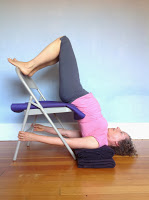
8. To come out of the pose, first bring your feet down onto the chair back.
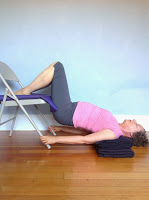
9. Next, bring your hands onto the front chair legs.Then drop your feet onto the chair seat as you slide away from the chair (or push the chair away from you).
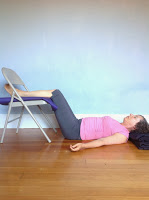
10. Keeping scooting until you are back far enough so you can drop your pelvis onto the floor. Then shift the blankets under your head so you can rest for a few breaths in a comfortable position.
11. Finally, roll over onto your side and rest there for a couple of breaths. When you’re ready, use your hands to slowly push yourself up to a seated position, only raising your head when you are fully upright. Taking your time coming out of the pose helps you retain the quietness you cultivated while you were in the pose.
Follow Yoga for Healthy Aging on Facebook ° To order Yoga for Healthy Aging: A Guide to Lifelong Well-Being, go to Amazon, Shambhala, Indie Bound or your local bookstore.


I feel there is so much that can go wrong with this especially if a person is trying it alone without anyone spotting them.
In my opinion practicing a modified shouldstand using a wall is much safer and just as effective. This chair shoulderstand looks scary to me.
I once injured myself very badly (my neck) using a chair with blankets under my shoulders while in a class with a teacher. We were practicing shoulderstand (with chair behind) to plow … to bridge. The blanket under my shoulders made the weight fall to my neck when going into bridge, and my legs were too much over my head resting on the chair. This was a pose I normally did on my own, but I thought I'd try the chair since the teacher was instructing that way. I was at a yoga retreat back then. I have been teaching yoga for 37 years and practicing for 45 years, and I really think that what you are showing is an injury waiting to happen. I never use a blanket under the shoulders since the injury I incurred 20 years ago that kept me away from shoulderstand for six months due to an injury to my neck.
I teach my students to use a wall to learn shoulderstand. I have never had a student injury themselves.
Could you please share pictures or a video showing how to use the wall instead. Thanks